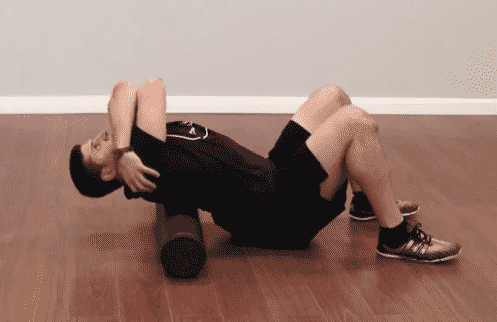3 Recovery Strategies for Overhead Training
July 2, 2015
Today, I have something special for you: an epic guest post by Matthew Ibrahim to optimize mobility and recovery in overhead athletes.
But wait. What if you’re not an overhead athlete?
Don’t fear. If you don’t play an overhead sport, thoracic mobility and the ability to move the shoulders overhead is still a huge problem with most lifters and athletes.
Rather than simply avoiding overhead work entirely, I opt for a proactive approach to improving thoracic mobility and stability.
This post by the king of Mobility 101 does exactly that. Over to you, Matthew.
— Constantly dealing with “tight” shoulders and upper back muscles?
— Are your overhead movements starting to feel restricted?
— Not sure of what to do on days in between overhead training to recover quicker?
Commonly, we see these issues arise in many populations across the board, from overhead athletes, to desk jockeys, to overhead powerlifters and Olympic lifters.
The primary objective here is to find a better solution to helping all of these individuals recover more quickly and efficiently from their overhead training and volume. Even more importantly, we need to find ways to help decrease or even eliminate any restrictions and tightness in their shoulders and mid-to-upper back areas.
DEVELOPING A MAINTENANCE ROUTINE
If you’re an overhead athlete (i.e., baseball, lacrosse, basketball, swimming, etc.), it will serve your body well to begin to follow a structured recovery routine in between bouts of play.
Similarly, if you’re an individual who often enters overhead patterns during training while being externally loaded with resistance (Olympic lifting, powerlifting, etc.), you’ll find it much easier to regenerate in between training sessions once you’ve adopted a solid recovery routine.
It’s important to note that recovery strategies shouldn’t only be performed on “off days”. They can also be performed on training/event days, both before and after. Also, be sure to give attention to the specific overhead patterns you tend to move through at high volumes as well.
Recovery Strategies For Overhead Lifting
It’s imperative for those individuals in the overhead training population to adhere to a recovery routine that yields quick and efficient results in terms of returning “fresher” each day.
Once a routine is set in place, it will become that much easier for folks to utilize overhead movements on a consistent basis, while decreasing the likelihood of setbacks and/or injuries.
Below, we will focus on 3 key areas for recovery strategies: soft tissue work, mobility, and medical exercise therapy.
Soft Tissue Work
The latissimus dorsii muscles (“lats”) and the thoracic spine are quite important when it comes down to performing soft tissue work (i.e., foam rolling) specific to recovering from overhead training.
Lats that present to be tight and knotted up tend to decrease overhead range of motion. Tight lats essentially pull down on the arms, which ultimately restricts overhead movement. Additionally, segments in the thoracic spine (mid-to-upper back region) that are locked in place without much freedom of movement also make it quite difficult to pattern overhead movements.
Quite simply put: your lats need to be long and supple, and your thoracic spine needs to have the ability to rotate and extend on-demand.
Below, I have outlined 3 specific items to focus on with respect to soft tissue work for overhead recovery strategies. Make sure to spend 45-60 seconds per item.
Mobility
When it comes down to it, there are a lot of nitty-gritty type of areas we tend to overlook when attempting to recover in between bouts of overhead training or events. Triceps and the forearms are often ignored.
And there are areas we tend to spend more time on, such as the shoulders, for obvious reasons. However, I think some folks miss the boat when connecting the dots between the actual patterns involved in their overhead training/sport and their recovery strategies.
Even more importantly, people don’t give much attention to thoracic rotation, which provides a wide gap they’re potentially missing out on for increasing their overall performance with respect to overhead movements.
In the next video, I have created a mobility routine specific to recovering from overhead training with 6 specific areas to work on. Perform 5-10 reps on each area.
Medical Exercise Therapy (MET)
MET can work like magic. I seen it over the past several years working in an outpatient physical therapy clinical setting. There’s a primary reason that it’s the “bread and butter” of the physical therapy/rehabilitative industry: results.
Generally, MET protocols call for 3 sets of 30 repetitions at very low weights. The benefits are increased circulation, tissue repair and range of motion, all of which are very important in any form of bodily recovery.
In short, MET typically gets viewed as a “rehab exercise”, or rather, an exercise that should only be performed by folks recovering from injury/surgery in a therapeutic setting.
This shouldn’t be the case, and quite frankly, a lot more of the opposite should occur. We should see more people out there utilizing MET protocols as a staple within their overhead recovery routine.
In the following video, I’ll show you 3 specific exercises to use moving forward. Perform 3 sets of 30 reps on each one.
About the Author:
Matthew Ibrahim is a hybrid strength and conditioning coach, due to his background and expertise in physical therapy with a trained eye for movement. His work is a combination of the fitness industry and rehabilitation field, which compliment each other through his hybrid approach to training. He has extensive knowledge in physical therapy, rehabilitation and injury-prevention as it pertains to human movement and performance in sports and function. Matthew is the owner of Mobility 101 in Medford, Massachusetts, a relentless pursuit to bridge the gap between rehabilitation and performance, ultimately building stronger, more efficient overall human movement through educational tools. Stay connected to Matthew:
Website– www.mobility-101.com Facebook– Mobility 101
Twitter– @mobility_101 Instagram– @mobility101
Find This Article Helpful?
I want to help you avoid my mistakes: you can start building your ultimate high-performance body and mind now. I’ve put together a free step-by-step guide to show you how.










[…] [This blog post was featured on BachPerformance.com. You can also read it HERE] […]
[…] 3 Recovery Strategies for Overhead Training — Matthew Ibrahim, Bach Performance […]
[…] 3 Recovery Strategies for Overhead Training – Eric Bach […]
[…] [This blog post was featured on BachPerformance.com. You can also read it HERE] […]